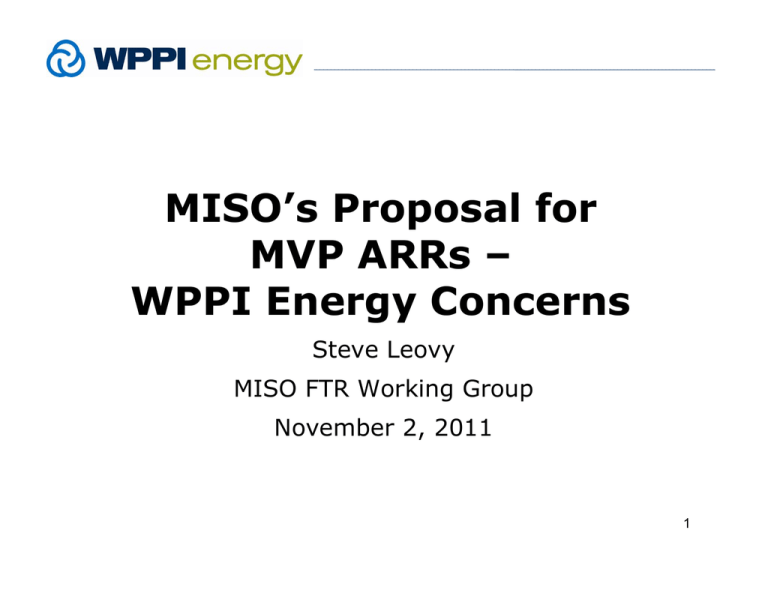MISO`s Proposal for MVP ARRs – MVP ARRs WPPI Energy Concerns
advertisement

MISO’s Proposal for MVP ARRs – WPPI Energy Concerns Steve Leovy MISO FTR Working Group November 2, 2011 1 Structure of Existing Market C Currently l iin MISO R Region, i nearly l all ll Generation G i is built by LSEs or by IPPs that have contracts with LSEs In order for LSEs to justify the Investment or Agreement to Purchase, they require some assurance of congestion protection The current MISO tariff provides a process – albeit imperfect – for adding ARR Entitlements for new Network Resources 2 Enter MVPs MISO now expects most transmission i i expansion i in the near future to take the form of MVPs – MTEP11 has $6 $6.5B 5B of new projects, projects $5.1B $5 1B of which are MVPs – MVP Portfolio will displace other kinds of projects: ~ “eliminates eliminates the need for baseline reliability upgrades on 23 lines between 2026 and 2031” [MTEP11 Draft p. 71] If MISO sets aside this capacity, it will not be available to support new ARR Entitlements for new capacity that would use the MVPs 3 MVP ARRs will Impair current MISO Market Structure Wi With h congestion i protection i less l certain, i it i will ill be b more difficult for LSEs to commit to new remote g generation Without LSE commitments, investment in new generation will be much more difficult This may affect the viability of the very same future generation that MVPs are intended to accommodate Unavailability of this capacity will also limit MISO’s MISO s ability to improve feasibility of existing LTTRs 4 Fairness Issue MISO and d some Stakeholders S k h ld maintain i i that h MISO needs to separately manage MVP FTR capacity p y to ensure that benefits are proportional p p to MVP charges It is not clear to WPPI that this is necessary – No similar argument has been made with respect to pre-MVP management of new FTR capacity – No effort is proposed to ensure strictly equal distribution of other MVP benefits, such as: ~ Gen and Load LMP Impacts o go e Baseline ase e Reliability e ab ty Project oject need eed ~ Forgone ~ Planning Reserve Margin reductions 5 WPPI Proposal MISO should h ld modify dif its i request to make k MVP capacity available to support RSP Addition and Replacement p requests q This should still leave significant capacity available for MVP ARRs Compromise approaches are also possible, in which part of the MVP capacity would be available for RSP Addition/Replacement 6 Offsets for RSP Addition IIt may be b reasonable bl to consider id reducing d i a party’s share of MVP ARR refunds to compensate for RSP Addition This would probably be most easily accomplished by converting MISO’s current proposal to devote all revenues to offsetting MVP costs to one in which MVP ARR revenues are allocated individually y among g eligible g recipients p on the basis of MVP-charge determinants 7 Conclusion WPPI B Believes li MISO should h ld modify dif its i MVP ARR Proposal so that some or all MVP capacity is available to support pp ARR Reserved Source Points for new resources, and increased feasibility for existing LTTRs. 8 Additional Questions WPPI requests addition to FAQ List 1 H 1. How will ill MVP ARR Options O i b be Defined D fi d in i the h Case of Initial Infeasibility? 2 How will MISO Prevent Adverse Impacts to 2. Existing LTTRs? 3. How will MISO determine which new Contingencies and Contingency Constraints to add along with new MVPs? 4. How will MISO ensure that auction-clearing prices for MVP ARRs are comparable to DA clearing prices? 9 Initial Infeasibility 1. How will MVP ARR Options be Defined in the Case of Initial Infeasibility? – – Under MISO’s Proposal, Non-zero quantities of ARR Options can only be defined if the MVP alleviates all pre-existing Stage 1B Binding Constraints How will MISO handle cases where MVPs exacerbate some constraints? 10 Impacts on Existing LTTRs 2. How will MISO Prevent Adverse Impacts to Existing LTTRs? – – MISO Proposes to Define MVP ARR Options on the Basis of Most-recent Stage 1B Allocation Results Recent Allocation Results Show Relatively little Overlap between Restoration and Stage 1B Binding Constraints Constraint Count Restoration Only Stage 1B Only Common – Summer 2011 Off‐Peak Peak 19 10 25 20 6 4 Fall 2011 Off‐Peak Peak 15 16 19 28 20 12 Winter 2011‐2 Off‐Peak Peak 11 10 22 21 0 4 Spring 2012 Off‐Peak Peak 14 17 26 16 6 8 Accordingly, Respecting Stage 1B Constraints Does Not Ensure Continued Feasibility of LTTRs 11 New Contingencies 3. How will MISO determine which new Contingencies and Contingency Constraints to add along with new MVPs? – – MVPs introduce new branches,, but also new contingencies Appropriate modeling of MVPs in Simultaneous Feasibility y Tests requires q consideration of all new contingency constraints that would be enforced in the DA Market 12 Annual Auction vs. vs DA Prices 4. How will MISO ensure that auction-clearing prices for MVP ARRs are comparable to DA clearing prices – – – Historically, y, MISO has awarded incremental FTR capacity in the Annual FTR Auctions for around $0.70 on the Dollar If this continues to be true for MVP ARRs,, it would likely mean a large loss for those who pay MVP charges. WPPI would like MISO to commit to monitoring g these prices, and propose adjustments as may be appropriate, as part of any MVP ARR filing 13 Comments? Questions? Steve S Leovy L WPPI Energy sleovy@wppienergy.org (303) 442-2871 14
